K812
back to AKG
back to measurements
home
published: Aug-30-2019
NO SMOOTHING is applied to the shown plots. Most measurement sites have some smoothing applied which ‘irons flat’ sharp peaks and ‘wiggles’. I do not use smoothing because some info about sound quality is lost when plots are smoothed.
Aside from a small correction of the microphone itself also some correction in the lowest frequencies is applied to the plots to compensate for the perceived loss of bass when using headphones. This is described HERE in more detail.
A ‘horizontal‘ frequency response curve on the shown frequency response plots on this website thus indicates a perceived ‘flat’ tonal signature.
ALL measurements are made with a good SEAL on a flatbed measurement rig.
The shape of your head, bone structure, pad size, pad ‘softness, (compliance), hair or no hair and or wearing glasses may (drastically) change the frequency response of some headphones, so… your personal experience may differ substantially from these plots.
Frequency response (tonal balance) is the most sound-determining aspect of headphones. A horizontal line shows audible neutral response in the plots on this website. Deviations in different severities at different frequency bands have an effect on the sound character.
The bigger the deviation the stronger the effect.
Below an aid to help determining the sound character of headphones with relation to the frequency response.


AKG K812
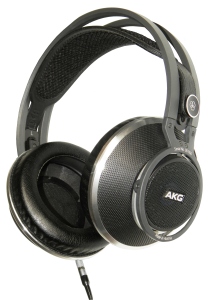
The AKG K812 is a semi-open dynamic headphone which is quite expensive (MSRP = € 1500.-). In 2019 the going price is around € 800.-
It also has a closed sibling the K872.
Both of these are the AKG Top-Of-The-Line headphones. The K812 is only available in black.
The reviewed and measured K812 has seen quite a few hours on it already so it isn’t a new version.
The headband can adjust over a fairly wide range and clicks quite firmly. The headband is cloth covered, it does not push hard on my head.
When it is set to the lowest position and you ‘stretch’ the headphone a bit to take it off the setting changes (with a ratteling sound because it changes a few ‘clicks’).
Every time I put it on I have to re-adjust the height which is annoying.
I guess this is the downside of not having the auto-adjustment elastic bands while adhering to a similar construction of the headband. Not having these elastic bands is a blessing fro longevity as all the AKG headphones using the elastic bands gave up being elastic after a few years already and are not easily replaced by the owner.
L and R markings are located on the inside headband on the height adjustment parts.
Another give-away for identifying the left cup is the cable entry.
The (excellent but expensive) LEMO 3-pin connector comes straight down from the left ear-cup but is placed more in front of you so the cable drapes in front of you instead of on your shoulder. The cable thus also does not have to bend. Partly because of this construction and the fact that the connector does not plug directly into the left cup there is very little microphonics from the cable as it doesn’t rub against clothes and is not directly coupled mechanically.
As some headphone enthusiasts prefer balanced or 4-wire cables on their headphone it is kind of surprising to see there is no possibility for this, given its price class.
Just like the Beyerdynamic DT1990 (and DT1770) there is only a 3-pin connector so going balanced is not an option.
The cable isn’t thin but also not ‘audiophile thick’ and 3m in length and just mildly microphonic. The cable terminates in a 3-pin 3.5mm TRS jack with a scre-on 6.3mm adapter. The K812 thus can also be connected to phones and DAPs with a 3.5mm TRS jack.
Given its high efficiency (110dB @ 1V) and low impedance this is a very viable option.
This means that if you have more than enough space in your luggage you could take it along with you and have good sound quality without needing to resort to extra amplification.
A portable headphone it is not. The 3 meter long cable, very open construction and size as well as no folding capabilities make it completely unsuited for anything other than enjoying/listening to music in very quiet conditions.
The pads are very large in inner diameter (70mm) and have a very nice depth (32mm) so all ears will fit without touching the headphone. The pads are pleather and are slightly shaped to better conform to ones head-shape. With the large diameter of the pads this is needed as well. The pads feel comfortable and have memory foam inside. This creates a good seal.
The clamping force is medium-high and pleasant. It ensures the headphone stays put and doesn’t move around when moving your head around.
This headphone is comfortable and can be worn for long periods without getting too ‘hot’ on the ears.
specifications:
Type: On-ear, semi-open
Usage: Home, Studio
Isolation: low (open headphone)
Driver type: dynamic
Pads: replaceable, fast memory foam covered with pleather
Pad dimensions: Ø 70mm , depth: 32mm
Collapsible: no
Headphone connector: LEMO FGG.00 push-pull 3-pin miniature
Cable entry: left sided.
Cable: 3m terminated in 3.5mm TRS + 6.3mm screw-on adapter
Driver size: ø 53mm but active area = ø 46mm
Nom. power rating: 0.3W (300mW)
Max. voltage: 3.3V
Max. current: 92mA
Max. S.P.L.: 121dB
Impedance: 36Ω
Efficiency: 96dB @ 1mW
Sensitivity: 110dB @ 1V
Weight: 390 g.
Color: black
Clamping force: medium
Accessories: 6.3mm adapter, wooden headphone stand, warranty card
Sound description:
The AKG K812 has a ‘bright neutral-ish’ and ‘ethereal’ tonal balance. The first impression is quite good and impressive when it comes to ‘open’ sound and details.
There is no deep rumbling bass though but bass is there, just not very present a bit subdued/lean.
Bass is light but is ‘tight’ and very well textured. The overall sound is ‘open’, dynamic and very ‘forward’ as well as ‘highly detailed’ and ‘delicate’.
Drum hits etc. are over-accentuated which gives it a very ‘dynamic’ sound.
It sounds a bit too bright and can have a laser-like sharpish ‘edge’ with some music. It is bordering on being sibilant The treble quality is better than that of its cheaper siblings.
measurements:
Below the frequency response of the K812 (Left, Right)
Channel matching is excellent. Bass extension is good. It starts to audibly roll-off from 100Hz down. This makes the bass sound ‘light’ but ‘tight’. At 20Hz the K812 is only 5dB down which is not much but audible none-the-less.
The mids from 100Hz to 4kHz are pretty flat and make the mids sound ‘neutral’. The small ‘dip’ around 4.5kHz is very narrow but deep.
The treble response is a bit ‘jagged’ but not as much as most of the other K-series.
Above 19kHz the response drops off but still shows response at least up to 30kHz.
comparison
Below a comparison between other well known ‘flagship’ headphones. The HD800S is in the same price class but the DT1990 is almost 2-3x as cheap but has very similar qualities (when fitted with the Analytic pads).
AKG K812, Sennheiser HD800S, Beyerdynamic DT1990-A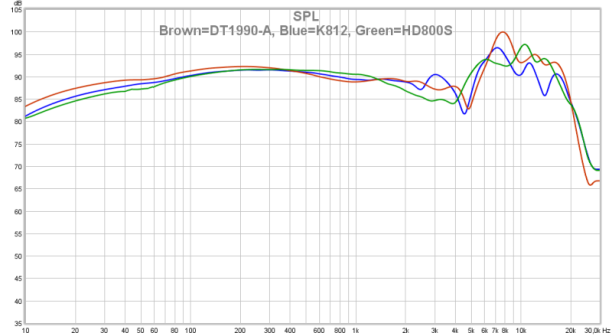
The K812 and HD800S both have very similar bass response. The DT1990-A has slightly more lows. From 1.5kHz the differences become a bit bigger. The K812 has a small peak around 3kHz where the HD800S has a dip. The DT1990-A is the most neutral in this part of the frequency range where ‘clarity’,’forward sound’ and ‘openness’ are present.
The treble region in all these headphones is elevated but in different parts of the frequency range. Sibilance is in the 6-8kHz range and ‘sharpness’ between 8kHz and 12kHz. As the treble is boosted in all these headphones they all have ‘hyper-detail’.
This is impressive when one first listens to these headphones but after a while this can become fatiguing. Sharpness and sibilance can become quite annoying.
The HD800S has the least amount of sibilance but the 10kHz peak can be somewhat ‘sharp’ with some recordings. The K812 has some sibilance but not nearly as much as the DT1990.
seal
As the seal of a headphone is of importance some experiments are done to see the effect.
(lots of) hair between the headphone and ear or an ear shape that does not allow a proper seal will affect the tonal balance.
Below: Perfect seal, a seal breach by thick armed (reading) glasses just above the skin and a big seal breach. A seal breach isn’t really problematic at all. The tonal balance is hardly changed when listening to these headphones with or without glasses. Only a very slight loss of sub-lows is observed when the seal isn’t perfect.
A seal breach isn’t really problematic at all. The tonal balance is hardly changed when listening to these headphones with or without glasses. Only a very slight loss of sub-lows is observed when the seal isn’t perfect.
output resistance / damping-factor
As this is a dynamic headphone the frequency response might be amplifier output resistance dependent when certain higher output resistance amplifiers are used.
To test this the headphone is measured via a low impedance amplifier (0.2Ω) and a high impedance amplifier (120Ω).
On a higher output resistance amplifier the output level will be considerably lower. To compensate for this the amplifier is cranked up to the same level (11.7dB at 1kHz) as the low impedance amplifier. This way the plots are overlay-ed and it is easier to show the tonal balance differences. The impedance does rise somewhat over a broad range resulting in about 1.5dB boost in the lows.
The impedance does rise somewhat over a broad range resulting in about 1.5dB boost in the lows.
The output resistance of the used source/amplifier has some influence on the sound so on high output impedance amplifiers (OTL tube amps etc.) this results in somewhat warmer bass/mids.
Below the distortion measurements of the K812 (Left channel) Below the same distortion plot but with the vertical scale in percentages instead of level differences.
Below the same distortion plot but with the vertical scale in percentages instead of level differences. 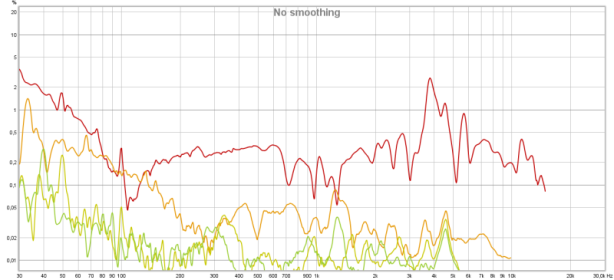
The 3rd harmonic and higher harmonics distortion are below 0.5% in the bass area (40-200Hz) which is quite good. The 2nd harmonic distortion remains below 2% in the bass which is a bit high from a 53mm driver. In reality the business ‘area’ of the driver is about 46mm in diameter though.
The 2nd harmonic distortion is probably lower than 0.1% around 1kHz as limits of the test rig are around that level.
The distortion around 4kHz is quite high and reaches an audible 2%. For lower frequencies a distortion at that level is much less audible. At 4kHz this can result in some instruments have some hint of ‘hardness’ to it.
Below the CSD of the K812. (Left and Right are superimposed)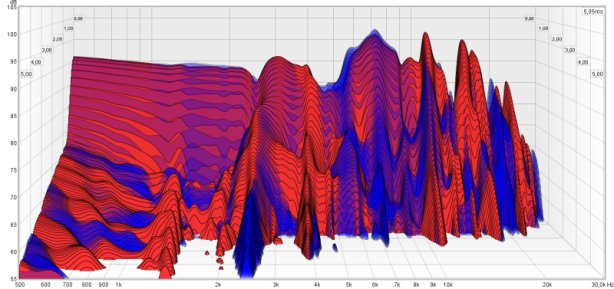
The dip around 4.5kHz is not as deep as the FR plot suggests (15dB) but is only about 5dB. Some small resonance around 3kHz which is not objectionable nor audible as our ear ‘rings’ a bit in that part of the frequency range anyway. The mids are pretty well damped. There is some ringing at frequencies above 6kHz but none are long lived.
Below the spectrum plot of the K812 (Right channel). 
This plot looks quite good below 500Hz. The lower frequencies are quite well damped and ‘stop’ fast.
Around 1.3kHz and 2.6kHz there is a little lingering (the small bump and dip in the FR).
The low level lingering between 1.5kHz and 8kHz is also sometimes seen with planar headphones. I don’t think this is very detrimental to the sound and about 50dB below the signal level. Above 10kHz the resonances are visible but are also short.
The step response plot below (Left, Right)
This plot shows the impulse response/clarity is accentuated and peaks out 3dB above the mids (beyond 1ms). The signal drops gradually and shows some bass roll-off. The ringing is damped fairly well.
7kHz peak filter
The plots all show there is quite a lot of ‘energy’ in the treble region. This is responsible for the ‘hyper’ detail and ‘brightness’ of the K812. Some owners may welcome this and even like this aspect. Others, such as me, prefer a smoother and more ‘realistic’ treble.
The exaggerated upper treble also causes listening fatigue for a lot of individuals.
To address this issue (for those that are actually bothered by it) I designed a passive inline filter (that goes between the headphone output and headphone cable) that lowers that treble emphasis only. This works much better than acoustical damping as the latter also damps higher frequencies which one does not want attenuated.
Below the schematic for the filter. When you can’t make one yourself or don’t know anyone close to you who can, you can order a filter here
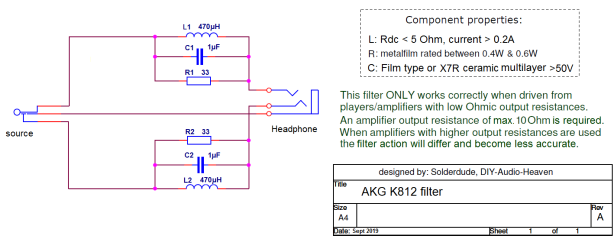
Below the effect of the filter (alternating between stock and filtered)
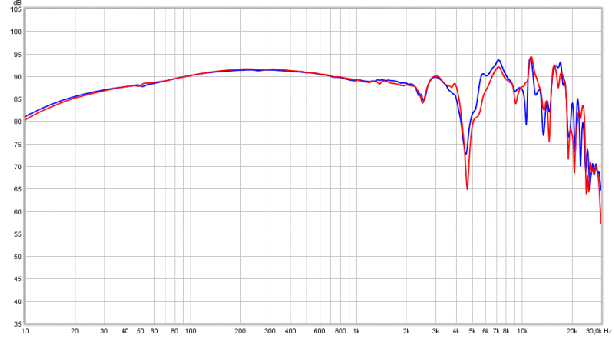 Bass and mids are not altered in any way. The ‘clarity’ (3kHz) is slightly (-1db) lowered.
Bass and mids are not altered in any way. The ‘clarity’ (3kHz) is slightly (-1db) lowered.
The 7kHz peak is lowered by 5dB. The 11.5khz peak also is slightly reduced.
This leaves enough ‘details’ and clarity and removes the ‘sharpness’ in the sound.
Below the CSD differences between stock and filtered.
Below the step response of the K812 with the inline filter.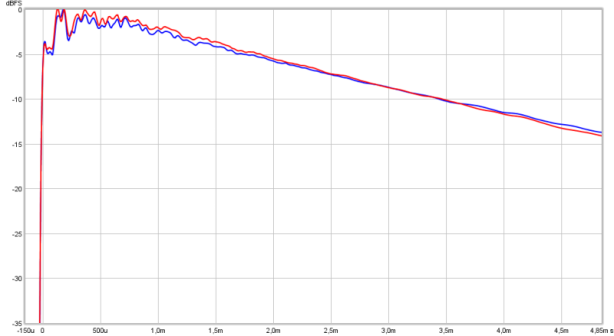
The sharp overshoot and dips are gone. The clarity is still there but the sharpness is removed.
Below the square-wave response of the K812 On the left the stock K812, on the right with the filter.
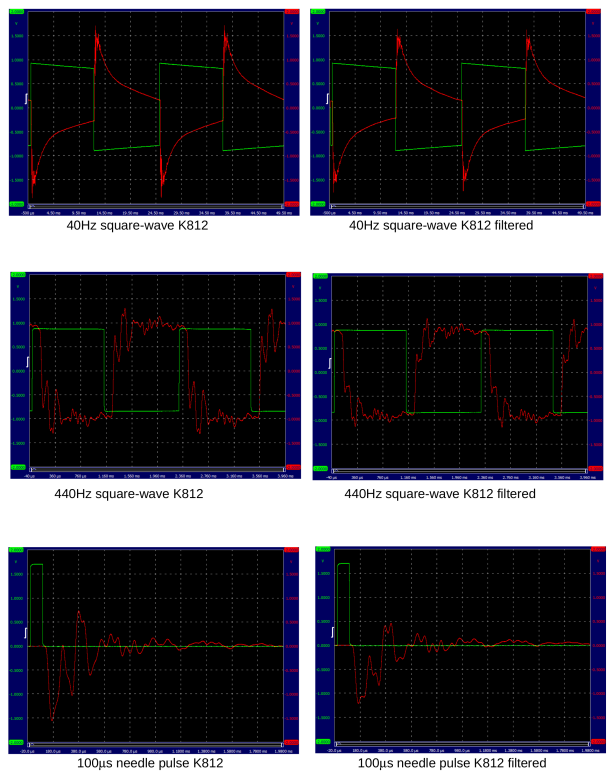
What is obvious here is the signal is inverted from the stimulus. This is not audible but a bit strange. I have also seen this in the DT1770 but not in the DT1990.
The bass slight roll-off is visible in the 40Hz square-wave. The signal doesn’t follow the stimulus in the horizontal plane and drops down. There is not much difference between filtered or not (as expected)
The mids (440Hz) looks more like the applied square-wave but does show quite a lot of ringing and overshoot (sharpness) in the stock condition. With the filter there is less ringing and no overshoot but the rising part is a bit ’rounded’ off.
The 100μs pulse almost reaches correct amplitude but the pulse on the top of the signal shows overshoot and a substantial amount of ringing.
With the filter the overshoot is no longer there and the waveform is more accurate but the amplitude doesn’t quite reach the desired level. The ‘bounce’ is smaller in amplitude as are the resonances resulting in more accurate reproduction.
summary
The AKG K812 is an expensive headphone that is slightly lean and bright sounding.
It sounds very dynamic, open, clear and detailed and has ‘flagship’ qualities.
Is it the perfect AKG ? No… but it is the best sounding one in their line up (haven’t heard the K872 though). The sound quality is above that of the K7** series.
Comfort is very good as well as the build quality.
Whether it is worth the MSRP is another story. I would say a more realistic price would be around € 750.-
A cheaper alternative is the Beyerdynamic DT1990. The DT1990 does need a treble filter. The K812 definitely becomes a more enjoyable headphone with a filter as well.
When one likes the elevated treble and hyperdetail as it is the filter is not needed.
In case one feels it sounds too ‘sharp’ on occasions the filter can certainly help.
Competition is there from Sennheiser (HD800S) and the more expensive planar headphones from HiFiman. Stax may also be an alternative.
The choice of the 3-pin headphone plug is a missed opportunity IMO.
Certainly a good headphone with some fine qualities. For AKG fans an excellent choice.
do k872 (or is it 875 ?)…….ohh…….and avantone pro planar plz!…….
Unless the manufacturer, an importer or an owner sends one to me they are not going to be reviewed as they are too expensive to buy on a whim and then end up on a shelf along with other headphones.
well…..ask them plz……uuuhh….oohhh…..
me really curious about both…..
me fun of hd600 and srh-1840….and maybe lcd-2 (the one more “flat”)
….but just have a k371 with an addon firefox equalizer 10 bands……..:):):)
I have the K712 (Slovenian) and a K702 65 anniversary (Austrian) They are two different headphones, the 65 anniversary is a lot better for music. I´m currently waiting for a Q701 I was able to get new, to compare the three.
The Q701 is a slightly warmer/bassier version of the K702, the K712 is a quite different sounding headphone from the K702/Q701 and K812.
I have never tried the regular k702, people who has say that they are two different headphones too. As a matter of fact, the k702 65 anniversary is the only headphone in the K7xx series, including the Q701 that its fact sheet has a frequency response of 8hz to 39,800hz. As all other in the series are specified to 10hz to 39,800hz
The anniversary version has different pads and is closer to the K712 than the K702
Right, they say that. But I find them very different. If you get the chance to try the 65 anniversary, let us know your thoughts.
Closer to is not the same as close to 😉 Slapping K712 pads on a K702 does not make the K702 sound like a K712. The drivers, rear damping and porting around the driver differs as well. It is not that all similar looking K*** models use the same driver.
Right, two different things. The capsules are different too, based on the part numbers.
Do you use your headphones for music or producing?
I just got the new set of Q701s. I will let you know what I find out. My intended purpose is just music.
I forgot to update you on this. The K702 65th anniversary has a deeper and punchier bass than the K712 and Q701.
I got a new set of flat pads (akg made, same as the ones on the 65th anniversary) for the K712 and did a comparison between them & the 65th anniversary. The K712 are probably a 95% of 65th anniversary, but I still felt the heavier bass on the annies and more presence, probably something between the margins of manufacturing, or not.
Now the Q701 (Austrian), they became my favorite, they are not as intimate as the annies since Q701 use the thicker and angled cups. I feel a wider soundstage and more airiness with the Q701.
Also the Q701 sound very good without EQ, as opposed with the K712 and K702 65th anniversary that EQ is a most. My least favorite headphones now are the K712.